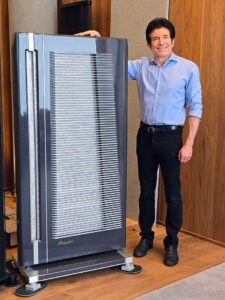Roger Skoff writes about what's good enough.
A great many years ago, I briefly owned a genuine Italian race car.
It was a Siata factory team car, built for the 1953 Targa Florio. It was red. It was gorgeous. It was homologated and barely street legal. It came equipped with both two seats and a windshield and, for racing, a tiny curved "racing screen" and a metal tonneau cover (to make it effectively a monoposto.) It was furiously fast and, with a racecar's very narrow power band and a six-speed "crash box" transmission (The Targa was famous for blowing transmissions, and a crash box [non-synchromesh] transmission could be made much stronger per weight), it was a chore to drive. I both loved and hated it, but it was certainly a girl magnet.
My father drove a Pontiac Bonneville at the time, and thought little of the Siata, declaring it to be uncomfortable, loud, impractical, and—most of all—unnecessary. After all, as he said, his car would do 55 miles per hour (the then California speed limit) at exactly the same speed as mine.
At least about the speed part, he was exactly right.
And that, of course, brings up the subject of LP turntables. I just recently saw a picture of one (which shall, for reasons soon to be obvious, remain nameless) that has to be the new pinnacle of a kind of design we see altogether too often in High End audio. It was colossal. It was thick. It was heavy. It had multiple motors. It had provision for mounting multiple tonearms. It was undoubtedly priced far above the stratosphere. It was, like my Siata, very beautiful and very exotic, and, as my father might have guessed had he seen it, at 33 1/3 rpm, it undoubtedly turns at 33 1/3 rpm.
And that's the point.
To my knowledge, the only reason—other than as a prestige item; because it enhances his décor; or as a "conversation piece"—that anybody would want a turntable is because you need one to play vinyl records. And, because those records are "cut" at a certain specific speed (even though they come in 16 2/3, 33 1/3, 45, and 78 rpm, let's call them all "LPs" from this point on), you need to play them back at exactly that same speed or all of the recorded frequencies will change. (If turned too fast, they'll get higher; if too slowly, they'll get lower).
Okay, that means that the turntable must turn at exactly the right speed. That's easy; all you have to do is to get (if it's a direct drive 'table) the motor to turn at the right speed. Or, if it's an in-direct drive (by a belt, a capstan, gears, a drive puck, or whatever else), all you have to do is, in the design or selection of the parts, choose the right-speed motor and make sure that the size ratios of all the other parts are such that they MUST give the right speed of turntable rotation.
You also need to have the speed be constant—with no low-speed (wow), or high-speed (flutter) variation. That's also easy: The first, easiest, and most obvious solution to any problem of speed variation is simply to increase the inertia—the tendency of things in motion to stay in motion—to keep the speed constant. That can be done by making the platter (the part that turns and that the record rests on) heavier or of greater diameter or both. Another term for this is "flywheel effect," and additional flywheels, either on or in addition to the platter and on or in addition to the motor (or motors) can bring turntable wow and flutter down to vanishing levels.
More speed constancy can also be gained by using a more constant motor: A 32-pole hysteresis-synchronous AC motor will be more speed-constant than a cheaper and more standard 4-pole AC motor (such as might be used on a washing machine). This is because of two things: First, having a greater number of poles in the drive means that power pulses will be far greater in number and smaller in size, and will thus be of less individual effect on speed. Second, because a synchronous motor locks onto the near-utterly-invariable 50 or 60Hz frequency of the power line, it's far more speed-stable, virtually immune to line voltage variations, and gives doubly better speed control. And, if a DC motor is used, as many modern turntables do, power pulses are—at least theoretically—eliminated entirely, and whatever remains (if anything) can be turned to heat and eliminated by using a high-hysteresis belt drive.
Speed accuracy and speed constancy can—as you ought to be able to see by now—be had by good design, well-executed, and aren't really either all that difficult or expensive to achieve. Even so, there are other considerations involved in making a good turntable.
One exceptionally good 'table from years gone by was made by RCA's Broadcast Audio division for playing 78 rpm transcriptions. (These were live disc recordings of radio broadcasts used by the networks for distribution to their affiliated stations in the days before tape recording.) Just the fact that they were turning at that speed greatly increased their angular momentum and increased their speed constancy accordingly. Also, transcription discs were 16 inches in diameter (to enable 15 minutes playing time at 78rpm), so the platter was 16 inches in diameter, too, which, just in itself, gave it more than triple the angular momentum of a 12inch modern platter turning at the same speed. That, coupled with the fact that the platter was concrete-filled and weighed 75 pounds made it about as speed-stable as is imaginable, even though it did use a four-pole washing machine motor as its drive.
So, what was the problem? Why aren't we using something like that today ?
Rumble – turntable bearing noise.
In those early days, the recordings were all in mono, which meant that all of the recorded signal was in the horizontal (side-to-side) plane, and that the cartridges used to play them were designed to respond only to side-to-side motion. That meant that the sound of that huge, heavy platter turning on its bearing, which included a substantial amount of vertical (up and down) rumble wasn't picked up by the cartridge, and everything sounded just fine.
When stereo discs came along, however, that all changed. Modern stereo LPs have the music signal recorded in two planes, both horizontal and vertical, rotated to be at 45 degrees to the turntable's plane of motion. That means that stereo phono cartridges have to be able to respond to both horizontal and vertical motion, and that bearing noise that was just fine for mono became audible in stereo, so new platter bearing designs had to be developed.
Still, that was able to be done, and it was done without being prohibitively expensive. So, what's left? Just two things: resonance and feedback.
The problem with resonance is significant and at least twofold: The first element of it is that everything—everything—resonates when stimulated, and that any application of energy that results in motion acts as a stimulus. So, for example, the dragging of the cartridge stylus through the record groove to play the record acts as a stimulus to get the record resonating and the resonance of the record acts as a stimulus to the turntable's platter to get it resonating, too. And that, in turn, applies more energy to the disc, and around and around it goes. That's why platters of different materials will make for different-sounding playback. And it's the same for platter mats, too. Anything from a felt disc (a la Linn), to rubber mats of different compositions, thickness and materials, to tempered glass discs, with or without coverings or treatments, can be used as a platter mat, and they all sound different.
That's because everything in the universe has a fundamental resonant frequency—a frequency that, when any stimulus is applied, it will resonate, regardless of the frequency of the stimulus. (The only difference that the frequency of stimulus makes is that the closer it is to the fundamental resonant frequency of the object being stimulated, the greater the amplitude (volume) of resonance will be.
Where this gets complicated, and what constitutes the second part of the resonance effect, is that it's not just the platter and platter mat that resonate and affect the sound. The turntable's plinth, its suspension system (if any), and the rack, table, or other surface that it's mounted on all have resonances, too, and they all—to at least some degree, no matter how minuscule—affect the sound.
Finally, there's the issue of feedback, either acoustic or mechanical. That's what happens when sound from a source goes out to speakers, is picked up by the source from those speakers, re-amplified, goes out again, and the process is repeated endlessly until it's finally stopped. You've all heard it as the horrendous squeal at a public event where the performers' microphones pick up the sound from the PA system and keep recirculating it until it turns into a howl that obliterates all else until the sound is turned down or off.
Well, you can also get it at home if—to cite the ultimate extreme example—your turntable is sitting on one of your speakers: In playing a record, the platter turns, the cartridge picks up signal and sends it to your amplifier, which sends the amplified signal out to your speakers—one of which your turntable is resting on, which physically shakes the turntable or acoustically shakes the cartridge—or both—which produces spurious signal which goes to the amplifier, which is sent to the speakers….and around and around again.
The problem is not so much that the example just given will actually be the case, but that unless the turntable is properly mounted on a vibration-free or vibration reducing stand, and unless similar precautions are taken against vibration coming through the air to the cartridge, there may also be—never a howl, perhaps, but always the subtle ghost of acoustic feedback—to act to color the sound of your system.
Although there are many potential solutions to problems of resonance and feedback, the two most commonly used are simple and can be fairly inexpensive. Adding mass is by far the most common, and is most commonly seen in the practice of using spiked (rather than soft) feet between components and their racks and/or the floor. If the spikes are really spikes, and really do tightly couple one mass to another (instead of having their effect mitigated or destroyed by placing pads or discs under the spikes to protect the underlying finish), the result will be an increase in the effective mass of the coupled objects which will result in the lowering of both their common resonant frequency and its amplitude. The other approach is to use energy absorptive feet (like Sorbothane or Norman Varney's EVPs) to turn otherwise resonant or feedback energy into heat before it can do its damage.
No, this article was not intended to be a thesis on turntable design, but to call for the exercise of reason in turntable manufacture and purchase.
Think about that gigantic, colossally heavy, and viciously expensive turntable I first mentioned. I have absolutely no doubt that it is great sounding and a marvelous thing to own. I do doubt, though, that whatever level of performance it offers can anywhere near justify its price. The reasons behind my thinking are simple and, to me, obvious. The first is that the function of a turntable is, itself, quite simple: It is to turn a record so that it can be played, and to turn it at a correct and unvarying speed, without bearing (or other operating) noise, and without either internally or externally generated resonance or feedback effects to affect the sound.
Now, remember how I described that turntable to you: " It was colossal. It was thick. It was heavy. It had multiple motors. It had provision for mounting multiple tonearms. It was undoubtedly priced far above the stratosphere. It was, like my Siata, very beautiful and very exotic, and, as my father might have guessed had he seen it, at 33 1/3 RPM, it undoubtedly turns at 33 1/3 RPM." Colossal, thick, and heavy are all ways to add mass. Mass is good, both for speed consistency and resonance control. Why multiple motors, though, especially when (as I should have mentioned) the turntable uses belt drive? We're not talking about a dragster, here, so quick acceleration is not a requisite, and with one good motor, a massive platter, and a pulse and/or speed variation absorbing belt drive, speed constancy can't possibly be an issue.
Also, why multiple tonearms? Unless you have 78s, which sound better if you use a special, larger stylus, cartridge, why do you need more than one tonearm per turntable? Do you simply like to switch back-and-forth, from one cartridge to another, while playing your records?
Anything that that turntable can do can be done by another turntable for far less money. And that leads to my second reason: Even if there is a difference in the performance of this table and another one, far cheaper than it, so what? If the problem is speed, speed constancy, or operating noise, because it's all physics, and the same solutions are available to every designer and manufacturer, I'm sure that the percentage difference in performance is vastly less than the percentage difference in price and is probably so small as to be imperceptible. And if the difference is in the sound, you'd be amazed at what just changing the platter mat can do.
Sorry, fellas, but this thing is a Siata. Exotic is wonderful, and if you can afford it and want to spend the money, good for you, but this time I'm going to go with my father and say that good enough is good enough; 55 mph is 55 mph, and 33 1/3 rpm is 33 1/3 rpm.
I'd buy a good, better-bang-for-the-buck turntable, and put the extra money into better other gear, better sound room acoustics, or more records. Do you agree?
Please respond in the DISQUS section.






































